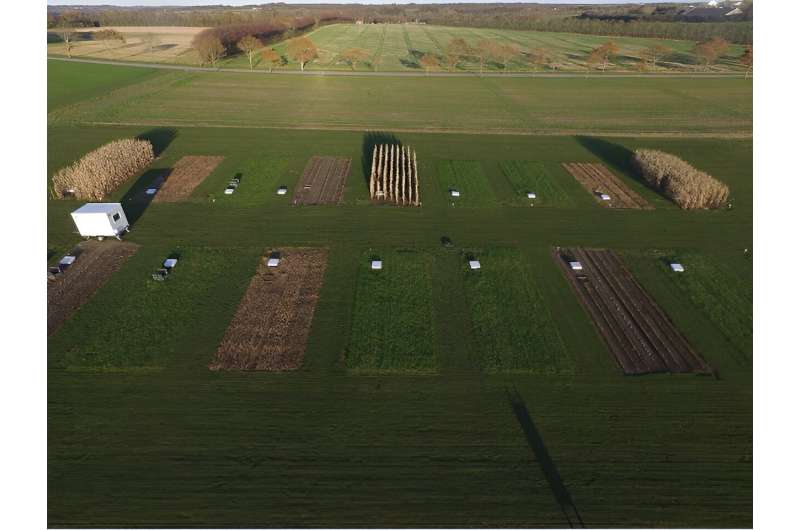This article has been reviewed according to Science X's editorial process and policies. Editors have highlighted the following attributes while ensuring the content's credibility:
fact-checked
trusted source
proofread
Researchers examine emission factors for nitrous oxide from synthetic and organic fertilizers

In a collaboration led by Aarhus University, researchers have measured nitrous oxide emissions during two years at four different locations in Denmark, where representative crop rotations had been established to provide a realistic context for the measurements.
The experiment included a crop rotation with milk production in Western Denmark, a crop rotation with milk production in Southwest Denmark, a crop rotation with pig production in Southwest Denmark, and a crop rotation with crop production in Eastern Denmark.
The four locations all have a low soil clay content typical for Northern Europe, while precipitation varied significantly from location to location and between the two years, 2020 and 2021.
Synthetic and organic fertilizers applied to spring barley
Spring barley was part of all crop rotations, and here three commercial fertilizers (NS, NPK and UAN) and eight organic fertilizers (three cattle slurries, three pig slurries and two digestates) were applied in 1 m2 subplots at either two or four locations. The exact same fertilizer materials were applied at the different sites to study the interactive effects of local conditions in terms of soil properties and precipitation. The same methods for fertilizer application, measurement and data analysis were used at all sites to ensure comparability.
"Our side-by-side measurements of nitrous oxide emission from a range of fertilizer materials in spring barley focused on the spring period. In the crop rotation, however, nitrous oxide emission was measured throughout the year in both experimental years, and these measurements confirm that most of the nitrous oxide emissions induced by spring fertilization occur before the crop has 'emptied' the soil of nitrogen," says Professor Søren O. Petersen from the Department of Agroecology at Aarhus University.
More attention to liquid manure
In the two experimental years, nitrous oxide emissions from commercial fertilizer were significantly lower than is currently assumed, while emissions from pig and cattle slurry and digestates were on average at level with or higher than previously assumed. This indicates that in Denmark, where 90% is handled as liquid manure, efforts to reduce nitrous oxide emissions from livestock manure will have the greatest effect on the climate.
"The level varied between sites and years, but we found that nitrous oxide emissions were on average higher from livestock manure than from commercial fertilizer at each of the four sites," says Søren O. Petersen.
Results differ from IPCC recommendations
Interestingly, the Danish results differ from the latest recommendations on nitrous oxide emission factors for wet temperate climate from the IPCC (Intergovernmental Panel on Climate Change). In the most recent guidelines, higher nitrous oxide emissions are expected from synthetic fertilizers than from organic fertilizers including livestock manure and digestates. This is based on a global analysis of experimental results.
"Both results may well be correct, because they are based on different data sets. It shows the importance of studies that represent local conditions," Søren O. Petersen explains.
Denmark is dominated by soils with low clay content, and almost all livestock manure is in liquid form with or without treatment in biogas plants. This combination provides favorable conditions for nitrification and denitrification, the two microbial processes that together cause the formation of nitrous oxide in the soil.
"The soil type is important because a well-aerated soil ensures good conditions for nitrification, but also provides good conditions for nitrous oxide produced in and around the liquid organic fertilizer to reach the atmosphere," says Søren O. Petersen.
In comparison, he explains, almost half of the studies included in the global analysis were done with solid manure, where the risk of nitrous oxide formation is lower because a significant part of the nitrogen may be lost during storage, and net release of nitrogen to the soil is low. More clayey soils will also have a greater tendency for poor air exchange, and thus less risk of nitrous oxide escaping from the soil.
The paper is published in the journal Agriculture, Ecosystems & Environment.
More information: Søren O. Petersen et al, Higher N2O emissions from organic compared to synthetic N fertilisers on sandy soils in a cool temperate climate, Agriculture, Ecosystems & Environment (2023). DOI: 10.1016/j.agee.2023.108718
Provided by Aarhus University


















